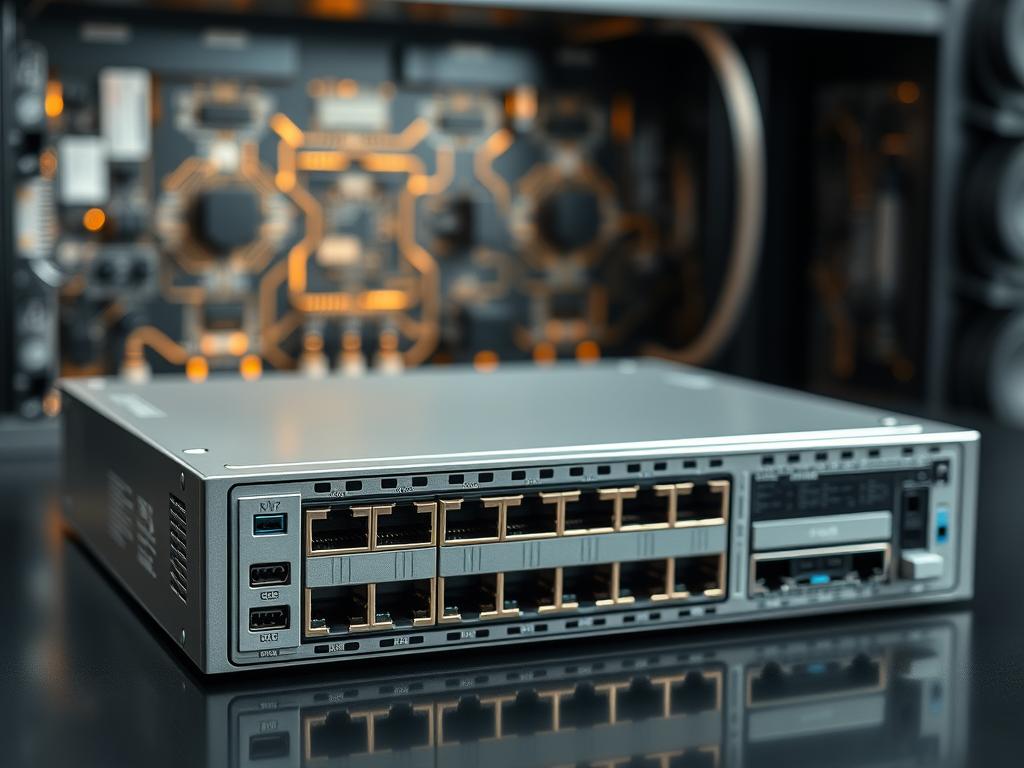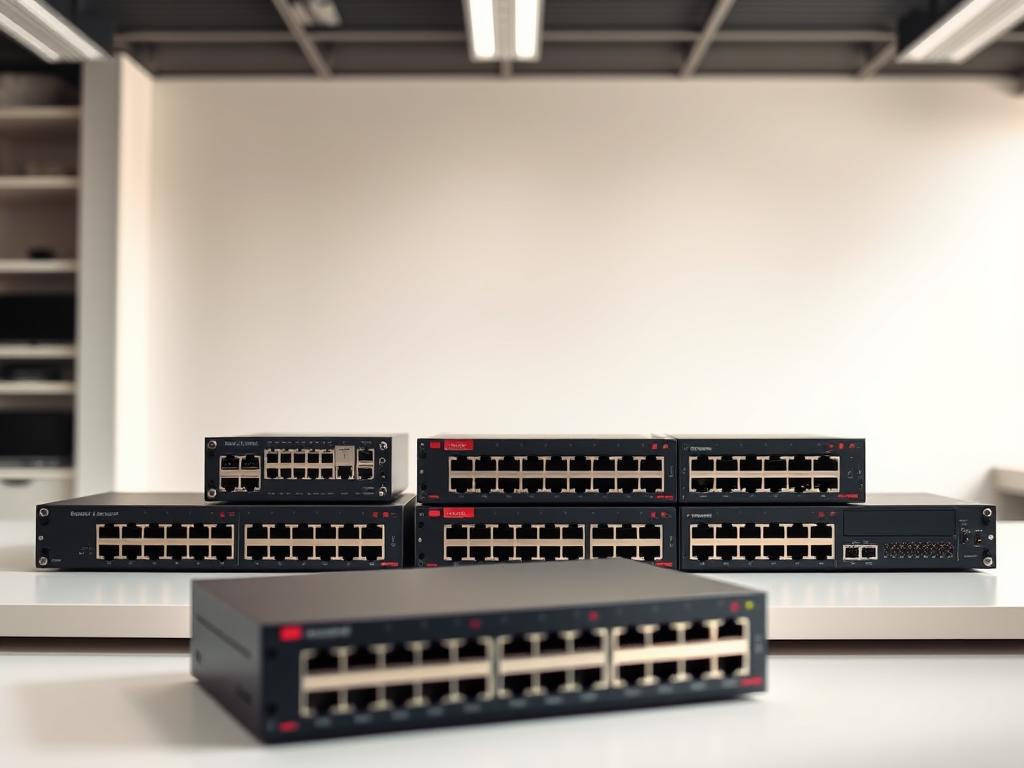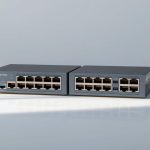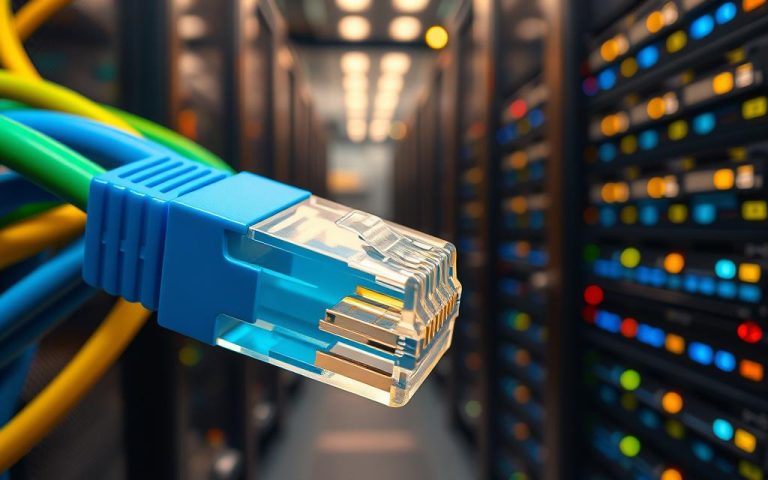What Are Switches in Computer Networks? Functions & Uses
Network switches are vital for seamless communication in modern digital environments. They connect multiple systems, enabling efficient data exchange. These devices form the backbone of contemporary data networks, handling massive traffic volumes.
Switch capabilities have advanced remarkably. Most now feature Power over Ethernet (PoE) technology. This innovation can deliver up to 100 watts of power to connected devices.
Enterprises and data centres rely heavily on network switches. The global switch market grew by 7.5% in Q3 2021. This growth highlights the increasing demand for these sophisticated networking solutions.
Modern switches offer impressive flexibility in configuration and operation. They typically feature 5 to 48 RJ-45 Ethernet ports or more. Switches can operate in full-duplex mode, quadrupling network speed compared to traditional half-duplex hubs.
Network switches go beyond basic connectivity. They maintain lists of MAC addresses for each connected device. This approach reduces communication collisions and eliminates broadcast domains. As a result, data transmission becomes more efficient and secure12.
Understanding Network Switches: Core Concepts
Network switches are vital for smooth digital communication. These smart devices manage data flow efficiently in various network setups. Network architecture relies on switches for effective data transmission.
Switches play a key role in managing data flow. They work with great precision at specific network communication layers. These devices boost network performance and ensure reliable data transfer3.
Defining Switch Operations
Network switches have several core operational features:
- Operate primarily at the Data Link Layer (Layer 2) of the OSI model4
- Utilise MAC addresses for precise data packet forwarding3
- Support full-duplex communication for simultaneous data transmission3
Network Architecture Insights
Switches stand out in network architecture through unique abilities:
- Create dedicated collision domains for each connection3
- Enable network segmentation to prevent traffic overloading3
- Support multiple communication types: unicast, multicast, and broadcast3
OSI Model Placement
A switch’s position in the OSI model shapes its function. Layer 2 switches focus on data transfer using MAC addresses. Advanced Layer 3 switches can route packets between different subnets4.
| Switch Type | Key Characteristics | Typical Use |
|---|---|---|
| Unmanaged Switch | Basic functionality | Home/Small Business Networks |
| Managed Switch | Advanced configuration options | Enterprise Networks |
| Layer 3 Switch | Routing capabilities | Complex Network Environments |
These core concepts shed light on network switches. They showcase the crucial role switches play in modern digital communication. Understanding switches is key to grasping today’s network infrastructure.
What Are Switches in Computer Network
Network switches are vital for managing data flow in computer networks. These smart devices transfer data packets efficiently between network devices. Ethernet switches are the most common type, enabling smooth communication across complex networks5.

Switches come in two main types: hardware devices and software-based virtual switches. They create separate collision domains for each port. This allows simultaneous data transfer without interference, ensuring top network performance5.
- Hardware switches: Physical network devices with dedicated ports
- Virtual switches: Software-based network management tools
- Layer 2 and Layer 3 network switches5
Data packet handling is crucial for switch functionality. Modern switches support multiple communication modes, including:
- Unicast (one-to-one communication)
- Multicast (one-to-many communication)
- Broadcast (one-to-all communication)6
Network experts can choose between managed and unmanaged switches. Managed switches offer advanced settings for complex enterprise networks. Unmanaged switches provide basic connectivity, ideal for smaller network setups6.
Key Features and Capabilities of Network Switches
Network switches are vital for modern digital communication. These smart devices offer crucial capabilities for efficient and secure network operations7.
Packet Filtering and Forwarding Mechanisms
Packet filtering helps switches direct network traffic intelligently. They examine data packets and make real-time routing decisions.
Advanced switches can track up to 1 million MAC address connections. This ensures precise packet management7.
- Examining packet headers
- Identifying destination addresses
- Forwarding data through optimal network paths
Bandwidth Management Strategies
Effective bandwidth management is crucial for network performance. Modern switches support connection speeds up to 1080 Gbps.
This enables organisations to handle substantial data throughput7. Key strategies include:
- Prioritising critical network traffic
- Implementing Quality of Service (QoS) protocols
- Distributing network load efficiently
Network Segmentation Capabilities
Network segmentation boosts security and performance through advanced technologies like Virtual LANs (VLANs). These solutions create logical network divisions within a single physical infrastructure.
They support thousands of device connections in one network7.
| Segmentation Method | Key Benefits |
|---|---|
| VLAN Implementation | Improved security, reduced broadcast domains |
| Layer 3 Switching | Enhanced routing capabilities |
Modern switches support sophisticated features like EVPN-VXLAN. This enables complex network architectures with better flexibility and security7.
Types of Network Switches
Network switches come in various forms to suit different networking needs. Understanding switch types is key for building effective network systems. Network switch technologies guide organisations in choosing the best option.
The main types of network switches are:
- Unmanaged switches: Simple plug-and-play devices for small networks. They need no setup and offer basic connectivity8. These switches are common in homes or small offices9.
- Managed switches: Offer full setup options for complex networks. They support advanced features like VLANs and quality of service10.
- Smart switches: Provide mid-level management, good for small businesses or network edges8.
Layer groupings matter in switch choice. Layer 2 switches work at the data link layer, moving frames within networks. Layer 3 switches add routing, enabling inter-VLAN talk and better network division10.
Other switch types include stackable and modular switches. Stackable switches let multiple units work as one, improving network growth9. Modular switches offer many port setups, some with up to 96x 25G ports8.
When picking a switch, think about port count, management features, and network needs. This ensures top performance and efficiency.
Network Switch Architecture and Operation
Network switches are sophisticated devices that form the backbone of modern computer networks. Their complex architecture enables seamless data transmission and efficient network management. Understanding their internal components and operational mechanisms provides insights into these critical networking tools.
The architecture of network switches includes several key components working together to facilitate smooth data communication. Switches operate at the Data Link layer (Layer 2) of the OSI model. They can also function at the Network Layer (Layer 3)11.
Switch Fabric Design
Switch fabric is the internal interconnection mechanism that enables data transfer between different ports. This critical design element determines the switch’s overall performance and scalability12.
Key characteristics of switch fabric include:
- High-speed data transmission paths
- Efficient packet routing capabilities
- Minimal latency during data transfer
Packet Processing Methods
Packet processing is a fundamental function of network switches. Switches direct data traffic based on Media Access Control (MAC) addresses. This ensures efficient data delivery across a Local Area Network (LAN)13.
The primary packet processing methods include:
- Store-and-forward switching: Checks entire packet before forwarding
- Cut-through switching: Forwards packets immediately after reading destination address
Port Configuration Options
Port configuration plays a crucial role in network switch functionality. Modern switches offer diverse port configuration features to meet varying network requirements11:
| Configuration Feature | Description |
|---|---|
| Auto-negotiation | Automatically determines optimal connection speed |
| Port mirroring | Duplicates network traffic for monitoring purposes |
| Power over Ethernet (PoE) | Delivers power through network cables |
These architectural elements and operational features contribute to the switch’s overall efficiency. They also enhance network management capabilities.
Implementation and Best Practices
Successful switch deployment needs a strategic approach to network infrastructure planning. Network optimisation starts with understanding your organisation’s specific needs. Managed switches are vital in creating robust network architectures.
When configuring switches, network admins should consider several key strategies:
- Select switches with appropriate port configurations14
- Implement VLAN segmentation for enhanced security
- Configure Quality of Service (QoS) settings
- Establish robust access control mechanisms
Enterprise network management involves configuring multiple VLANs and ensuring secure remote access. Most organisations use about 10 VLANs per managed switch. Standard configurations support 8 to 48 ports14.
Security is crucial, with 85% of network professionals prioritising secure access protocols like SSH14.
| Switch Configuration Parameter | Recommended Setting |
|---|---|
| Console Connection Baud Rate | 9600 bps14 |
| RSA Key Generation | 2048-bit modulus14 |
| Remote Access Lines | 16 VTY lines14 |
Key best practices include regular configuration backups and using command-line interface (CLI) features. These tools can reduce configuration mistakes by up to 30%14.
Effective switch management can boost network performance by 40% when following best practices14.
Conclusion
Network switches are vital for modern data communication. They drive efficiency in digital ecosystems. These devices enable seamless connectivity and resource sharing for organisations1516.
The networking landscape is changing rapidly. Switches now offer advanced features like QoS and VLANs. These enhancements boost security and performance in networks17.
Future switches will likely become more intelligent. They may support software-defined networking architectures. This evolution will meet emerging technological demands15.
Switches optimise data transmission in various settings. They reduce network congestion and manage bandwidth effectively. These devices also provide dedicated communication channels16.
As technology grows more complex, switches remain crucial. They ensure efficient, secure, and scalable digital infrastructure. Their importance in networking will continue to increase15.
FAQ
What is a network switch and how does it differ from a router?
A network switch links devices in a local area network (LAN). It forwards data packets using MAC addresses. Switches work at Layer 2, managing communication within the same network.
Unlike routers, switches don’t route traffic between different networks. They create dedicated channels between specific devices for efficient communication.
What are the main types of network switches?
The main switch types are unmanaged, managed, smart, stackable, and modular. Unmanaged switches are basic plug-and-play devices. Managed switches offer advanced configuration and monitoring.
Smart switches provide some management features. Stackable switches can be interconnected. Modular switches have expandable port configurations.
How do switches improve network performance?
Switches boost network performance through smart packet forwarding. They maintain MAC address tables for direct device communication. This reduces network congestion by creating dedicated paths.
Switches support bandwidth management and implement Virtual LANs for network segmentation. They use advanced methods like store-and-forward and cut-through switching.
What is the difference between Layer 2 and Layer 3 switches?
Layer 2 switches use MAC addresses to forward packets within a local network. Layer 3 switches can perform routing functions and use IP addresses.
These switches forward packets between different network segments. They combine the abilities of both switches and routers.
What are VLANs and why are they important?
Virtual Local Area Networks (VLANs) are logical network segments. They group devices across different physical networks. VLANs improve network security and reduce broadcast domain sizes.
They enhance network performance and offer flexible management. VLANs logically separate network traffic for better organisation.
What is Power over Ethernet (PoE), and how do switches support it?
Power over Ethernet (PoE) allows switches to power devices through network cables. It works with IP cameras, wireless access points, and VoIP phones.
PoE-enabled switches deliver power and data at once. This simplifies device installation and reduces the need for separate power sources.
How do managed switches differ from unmanaged switches?
Managed switches offer advanced features like network monitoring and configuration options. They support VLANs, quality of service settings, and security controls.
Unmanaged switches are basic plug-and-play devices with no configuration options. They suit simple network setups with minimal management needs.
What security features do modern network switches provide?
Modern switches offer port security and access control lists. They include MAC address filtering and 802.1X authentication. Storm control prevents network disruptions.
Switches can create isolated network segments through VLANs. This helps protect sensitive network resources from unauthorised access.
Source Links
- What is a Network Switch? How it Works and Types – TechTarget Definition
- What Is a Network Switch?
- What is a Network Switch and How Does it Work? – GeeksforGeeks
- Network Switches: What Are They and How Do They Work?
- Network switch
- Switches in Computer Networks
- What is a network switch? | Juniper Networks US
- What Are the Different Types of Network Switches?
- 10 Different Types of Network Switches used in LAN Ethernet Networks
- What are the different types of network switches? | TechTarget
- What is a network switch and how does it work?
- The differences between managed and unmanaged switches
- How do network switches work?
- Detailed Guide to Basic Switch Configuration
- What is a Network Switch? | Explained Working, Types, Applications and Architecture of a Network Switch
- What is a switch and what functions does it perform? –
- Switch in Computer Network















